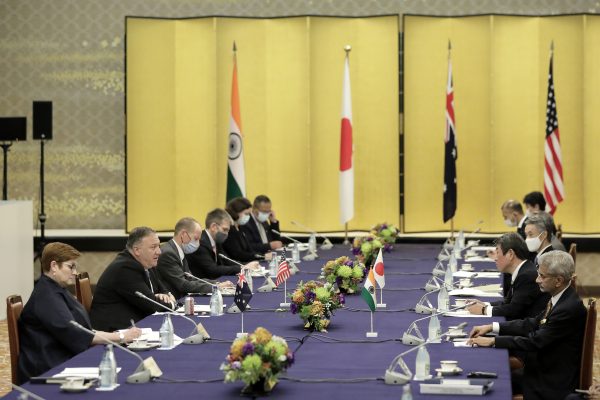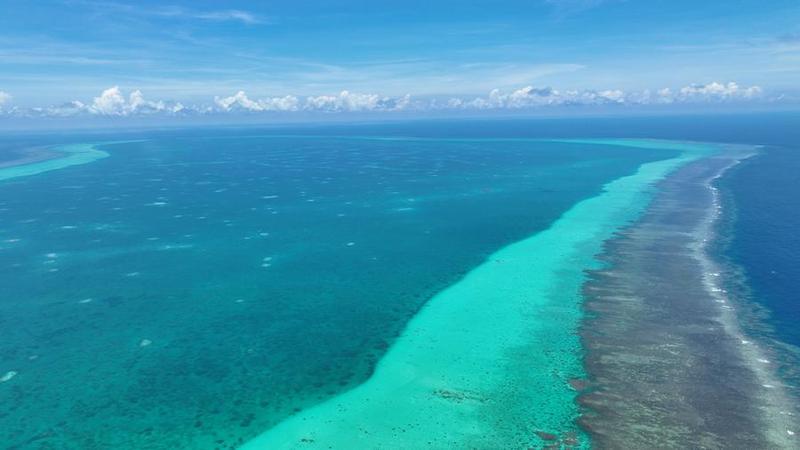Institutionalizing the Quad?
With an increasingly aggressive China, some argue it is time to institutionalize the security framework.
When Japanese former foreign minister Taro Kono announced his vision to revive the security meetings between Japan, Australia, India and the United States (known as the Quad) in October 2017, he proposed to upgrade the meeting from the original sub-cabinet level to foreign minister level toward a summit level “strategic dialogue” in the coming years.
Trump administration officials from the U.S. State Department such as Deputy Secretary Stephen Biegun and Secretary Mike Pompeo also hinted at the possibility of formalizing the QU.
Might the Quad become more institutionalized? If so, what form would it take? In fact, it might be useful to refer to the Trilateral Strategic Dialogue (TSD) between Japan, Australia and the United States, which has a more formal structure than the QU.
Like the Quad, the TSD started as an informal meeting among senior officials in the early 2000s. Since then, the three countries have frequently collaborated in non-traditional security fields such as counter-terrorism, non-proliferation and humanitarian assistance missions.
Diplomat Brief Weekly Newsletter N Get briefed on the story of the week, and developing stories to watch across the Asia-Pacific. Get the Newsletter
Subsequently, the TSD was upgraded to the ministerial level in 2005, and the first foreign ministers’ meeting was held in March 2006. The following year, the three countries’ leaders for the first time held a breakfast meeting during the APEC summit in Sydney.
Enjoying this article? Click here to subscribe for full access. Just $5 a month.
TSD officials have also discussed in different working groups various issues such as counter-terrorism, humanitarian assistance and disaster relief, and cooperation in the South Pacific.
While the TSD is led by the foreign ministries of the three countries, another defense-oriented mechanism, the Security and Defense Cooperation Forum (SDCF), was also launched in 2007. The SDCF has served as a forum for working-level discussions between the three countries’ defense and foreign officials in areas like maritime security and missile defense. The three defense ministers also met trilaterally for the first time on the sidelines of the Shangri-La Dialogue in 2007.
Will the Quad follow the path of the TSD? In other words, will it become an official “Quadrilateral Strategic Dialogue (QSD)” that includes regular working-level discussions?
In fact, there are many differences, as well as similarities, between the TSD and the Quad. While both are groups of capable democracies in the region, Japan and Australia are U.S. allies, while India is not.
While Japan and Australia have belonged to the Western community since the end of World War II, India has carefully avoided becoming involved in any ideological bloc, maintaining its “non-alignment” during the Cold War and “strategic autonomy” after the Cold War.
Although its economy has grown rapidly, India still needs to protect its domestic economy from external competition, as demonstrated by its recent withdrawal from the Regional Comprehensive Economic Partnership. India also did not join the infrastructure investment partnership with the TSD countries.
Most importantly, while Japan and Australia wish to see U.S. strategic primacy or leadership retained in the region, India, as a nuclear power, wants a more multipolar regional order. For Japan and Australia, a multipolar Asia could be the consequence of the recent power shift in the region, but not to the point of the “desirable regional order” envisioned by India.
There are also disparities in strategic priorities even among TSD member states. The United States is most concerned about its “strategic competition” with China over regional dominance. Taiwan, Hong Kong and human rights issues are likely to remain high on the agenda under the new Biden administration.
As it faces a range of domestic issues, the new administration will also expect, like its predecessors, greater burden-sharing from regional allies and partners in responding to regional threats.
While Japan has played a growing security role under the banner of the Free and Open Indo-Pacific, it has been increasingly concerned with China’s aggressive posture in the region. Nevertheless, Japan seeks to maintain a good relations with China, given economic and political considerations. This is actually one of the reasons why Japan wants the U.S. to retain strategic primacy, as it provides a necessary condition for Japan’s continuous and constructive engagement with China.
Enjoying this article? Click here to subscribe for full access. Just $5 a month.
Meanwhile, Australia’s relations with China have continuously deteriorated, and public perceptions of China are at their worst ever level. Yet, unlike Japan’s threat perceptions for China, which mostly come from China’s growing physical presence in the region surrounding Japan, Australia’s arise from non-material or non-military threats, such as political interference, espionage, cyber-attacks and economic coercion. Unlike Japan, which primarily focuses on the East China Sea, Australia has been worrying about China’s militarization of the South China Sea and its greater influence in the South Pacific.
Despite such disparate geopolitical interests, Japan and Australia have worked closely together to support the U.S. strategic primacy in the region as the ultimate guarantee of their security. Again, India does not necessarily share the strategic perceptions of Japan and Australia, although it has increasingly tilted to balancing against China.
All things considered, it seems unlikely that the Quad will evolve to an institutionalized structure at the level of TSD, at least not in the short term. Although the four countries could hold regular meetings at a ministerial or even summit level, it is not clear if this political momentum would lead to collective actions on divergent security issues at a practical level beyond the maritime domain.
This is not to suggest that the Quad is unimportant. Even if they cannot institutionalize their collective military actions in multiple fields, the four countries could coordinate their policies to individually or, sometimes collectively, “push back” against China’s growing regional influence, in areas like infrastructure development, capacity building, humanitarian assistance and disaster relief, defense equipment, cyber and outer-space security.
Japan and regional partners can also enhance bilateral and “minilateral” security cooperation in the region. In addition to the traditional U.S.-led “hub and spokes” alliances, the region has seen greater “spokes to spokes” or intra-allied alignment or security cooperation over the past decade. These bilateral and minilateral frameworks could potentially upgrade the U.S.-led bilateral alliance structure to a more “networked” security architecture.
At the same time, it should be recognized that such “spokes to spokes” cooperation is unlikely to be an alternative to the U.S.-led hub and spokes alliance structure. While increasingly boosting their defense capabilities, regional middle powers still expect a strong U.S. military presence in the region. It remains to be seen whether the new U.S. administration will be able to meet this demand.
SATAKE Tomohiko is a senior research fellow of Japan’s National Institute for Defense Studies (NIDS). Views expressed in this essay are the author’s own and do not represent those of NIDS or the Ministry of Defense of Japan.












